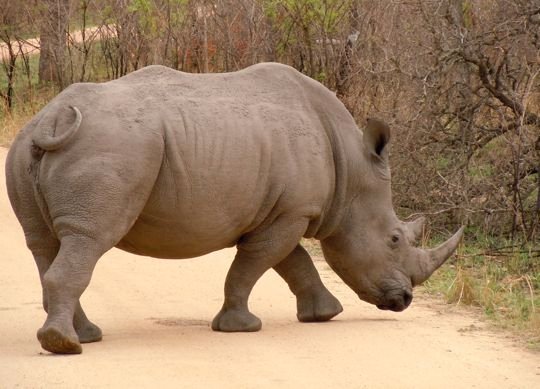Juan (pronounced “John”) George has been a student of the animals in Kruger National Park since he was four years old. At that time, his grandfather, Johan, was an honorary ranger who started early teaching his grandson the names of the animals and their habits. Juan has been a guide for Eastgate Safaris & Transfers for seven years, and now his own son is four years old and is learning the animals. “By the time he’s six I plan to just drive and let him give the tour,” Juan told us at the end of this morning’s game drive, our third into Kruger in two days.
As Juan explained previously, luck plays a big part in how successful any given drive through the park is for the visitors. The chances of reaching any particular spot on the roads of the vast park at precisely
the same moment a pride of lions crosses is not great, nevermind the odds of seeing an elusive leopard. That said, Juan works hard to get lucky, and it pays off for his guests. I also found it impressive how he maneuvered his 10-seat Toyota Land Cruiser whenever we did come upon great opportunities to photograph the park’s citizens. He would inch the vehicle ahead or behind a few feet so all of us had unimpeded views of the white or black rhino, the lions, the tsessebe, the omnipresent impala, and various colorful birds. He seemed to know when the elephant would cross the road, if not why. In fact, part of what I respected about our guide was how freely he admitted what he didn’t know about the habits of the animals. His respect and understanding of nature struck me as the sort a grandfather passes down to a grandson, who does the same to a son.
After yesterday’s Shake ‘N’ Bake afternoon drive, in temperatures well over 100 degrees Fahrenheit, none of us expected to spend most of this morning’s ride shivering with cold. I’d cleverly decided to wear shorts instead of my convertible long pants that zip off the lower legs as needed. As the drive went on, we wrapped ourselves in the steamer rugs thoughtfully provided at each seat, and at a comfort stop I purchased a scarf and warm hat with the national colors of South Africa. But I can assure you that when an elephant stepped across the dirt road or a giraffe hove into view eating the tall leaves, the  shivering ceased and total attention took over.
shivering ceased and total attention took over.
Part of our Gate1 contingent had missed the spectacular sighting of lions which Darlene, Deb and I had experienced yesterday morning, so finding the King of the Jungle was high on everyone’s list. Somehow Juan got news of a likely spot, either from his two-way radio or passing info exchanged with other guides as our vehicles stopped when meeting on the roads. We approached a dry river bed and saw three female lions in the distance, close enough for the zoom lenses to get decent shots. Then, as if they, too, were curious about the hubub of vehicles gathering, the lions strolled closer to the road. One of my photos from that sighting has the face of a lion appearing almost as a mirage through tall grass, but I didn’t quite capture a clear shot of her eye, so it just missed being blog worthy.
An overall impression I have is how desolate the landscape is within Kruger. The rainy season normally begins by now, and you can see green leaves appearing like implausible hope at the ends of gray, dead-looking branches. But the dryness and heat of the climate takes its toll, so I found myself surprised that the area can support such impressive animals with such big appetites. Part of the explanation is that some of them eat each other, and the sense of nature’s harsh ways is palpable in the park. Juan pointed out the carcass of a Cape buffalo yesterday, explaining how strong the ribs are and what damage they will do to a vehicle which runs into one of the buffalo. The stark white curves laying on the ground made it clear that survival of the fittest is not just a theory for Kruger’s inhabitants.
Being used to Yellowstone National Park, where animals can wander in and out as they please, I was surprised to learn that Kruger is surrounded by an electric fence which keeps the animals on location. This disappointed me at first, reducing the sense that I was in a completely natural environment. But the vast size of the park assures that Kruger is to a zoo what the Atlantic Ocean is to the Reflecting Pool in Washington, D.C.
I’ll be pawing through the hundreds of photos I took for more shots to highlight in various ways, and Darlene is already imagining a quilt based on one of my scenes. She was the only one on the Land Cruiser without a camera, which left her attentive to the animals perhaps more directly, with her binoculars. I know she was soaking in the experience on her own wavelengths, as was Deb, and that we were all changed by the chance to spend so much time in the presence of these creatures, with the help of a very memorable guide.
 Send to Kindle
Send to Kindle


